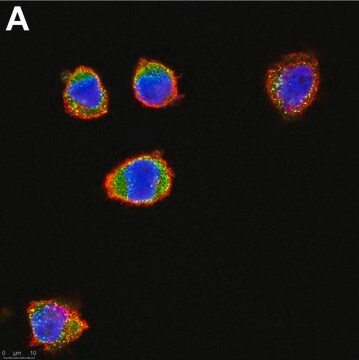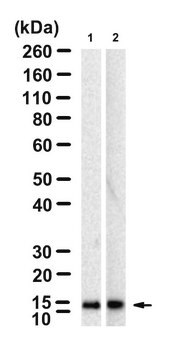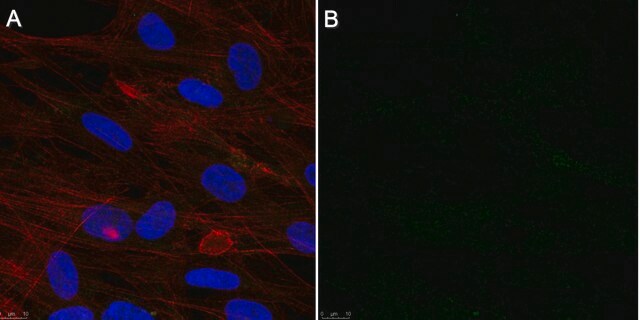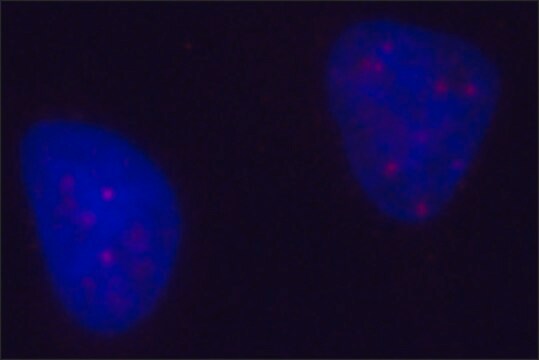Allgemeine Beschreibung
We are committed to bringing you greener alternative products, which adhere to one or more of The 12 Principles of Green Chemistry.This antibody is Preservative-free, produced without the harm or sacrifice of animals and exceptionally stable to allow for ambient shipping and storage if needed and thus aligns with "Waste Prevention", "Designing Safer Chemicals" and "Design for Energy Efficiency".
Click here for more information.
ZooMAb® antibodies represent an entirely new generation of recombinant monoclonal antibodies.Each ZooMAb® antibody is manufactured using our proprietary recombinant expression system, purified to homogeneity, and precisely dispensed to produce robust and highly reproducible lot-to-lot consistency. Only top-performing clones are released for use by researchers. Each antibody is validated for high specificity and affinity across multiple applications, including its most commonly used application. ZooMAb® antibodies are reliably available and ready to ship when you need them.
Spezifität
Clone 8B1.2 is a ZooMAb® mouse monoclonal antibody that detects immediate early antigen in cytomegalovirus infected human cells.
Immunogen
Affinity purified immediate early antigen from MRC-5 cells infected with Human Cytomegalovirus Strain AD169
Anwendung
Quality Control Testing
Evaluated by Immunocytochemistry in MRC-5 cells infected with Cytomegalovirus.
Immunocytochemistry Analysis: A 1:100 dilution of this antibody detected immediate early antigen in MRC-5 cells infected with Cytomegalovirus.
Tested applications
ELISA Analysis: A representative lot of this antibody detected Cytomegalovirus mix antigens.in ELISA Application.
Immunohistochemistry (Paraffin) Analysis: A 1:100 dilution from a representative lot detected immediate early antigen in FFPE cell pellet sections containing cytomegalovirus infected MRC-5 cells.
Note: Actual optimal working dilutions must be determined by end user as specimens, and experimental conditions may vary with the end user
Anti-Cytomegalovirus, clone 8B1.2 ZooMAb®, Cat. No. ZMS1015, is a recombinant Mouse monoclonal antibody that detects immediate early antigen in cytomegalovirus infected cells and is used in ELISA, Immunocytochemistry, and Immunohistochemistry (Paraffin).
Zielbeschreibung
Cytomegalovirus (CMV) is a prototype b-herpes virus that is ubiquitously distributed in the human population and is known to cause silent pandemic in immunocompromised subjects. Following a primary infection, which is usually asymptomatic, the virus can establish a latent infection and can be re-activated. The CMV replication cycle has three distinct phases that are designated as immediate early (TE), early (E) and late (L). The immediate early antigens are 72 kDa IE1 and 86 kDa IE2 phosphoproteins that are the first de novo synthesized proteins following primary CMV infection or re-activation. They play an important role in the immune response and are recognized by specific T cells. While IE2 is reported to be absolutely indispensable for productive viral replication, IE1 is only conditionally essential and appears to synergize with IE2 to promote transcriptional activation of the viral early genes. Although IE2 is the principal transcriptional activator of the CMV early genes, it can also negatively regulate viral gene expression after low infection. IE2 is also shown to block virus-induced expression of several inflammatory chemokines, including IL-8, MCP-2, MIG, MIP-1a, and RANTES. It also blocks host cell DNA replication. Both, IE1 and IE2 are reported to delay cell death in infected cells and even block apoptosis. Ectopic IE1 is shown to trigger a p53-dependent G1 growth arrest response, while it induces quiescent cells to enter S phase in p53-negative cells. IE1 also shown to antagonize the type I interferon by interfering with Jak-STAT signaling. This ZooMAb® recombinant monoclonal antibody, generated by our propriety technology, offers significantly enhanced specificity, affinity, reproducibility, and stability over conventional monoclonals. (Ref.: Maidji, E., et al. (2017). PLOS Pathogens. 13(2); e1006202; Christina Paulus, C., and Nevels, M. (2009). Viruses. 1(3); 760-779; Van Zanten, J., et al. (1991). Clin. Exp. Immunol. 83(1); 102-107).
Physikalische Form
Purified recombinant mouse monoclonal antibody IgG, lyophilized in PBS with 5% Trehalose, normal appearance a coarse or translucent resin. The PBS/trehalose components in the ZooMAb® formulation can have the appearance of a semi-solid (bead like gel) after lyophilization. This is a normal phenomenon. Please follow the recommended reconstitution procedure in the data sheet to dissolve the semi-solid, bead-like, gel-appearing material. The resulting antibody solution is completely stable and functional as proven by full functional testing. Contains no biocide or preservatives, such as azide, or any animal by-products. Larger pack sizes provided as multiples of 25 μL.
Rekonstituierung
30 μg/mL after reconstitution at 25 μL per vial. Please refer to guidance on suggested starting dilutions and/or titers per application and sample type.
Lagerung und Haltbarkeit
Recommend storage of lyophilized product at 2-8°C; Before reconstitution, micro-centrifuge vials briefly to spin down material to bottom of the vial; Reconstitute each vial by adding 25 μL of filtered lab grade water or PBS; Reconstituted antibodies can be stored at 2-8°C, or -20°C for long term storage. Avoid repeated freeze-thaws.
Rechtliche Hinweise
ZooMAb is a registered trademark of Merck KGaA, Darmstadt, Germany
Haftungsausschluss
Unless otherwise stated in our catalog or other company documentation accompanying the product(s), our products are intended for research use only and are not to be used for any other purpose, which includes but is not limited to, unauthorized commercial uses, in vitro diagnostic uses, ex vivo or in vivo therapeutic uses or any type of consumption or application to humans or animals.







